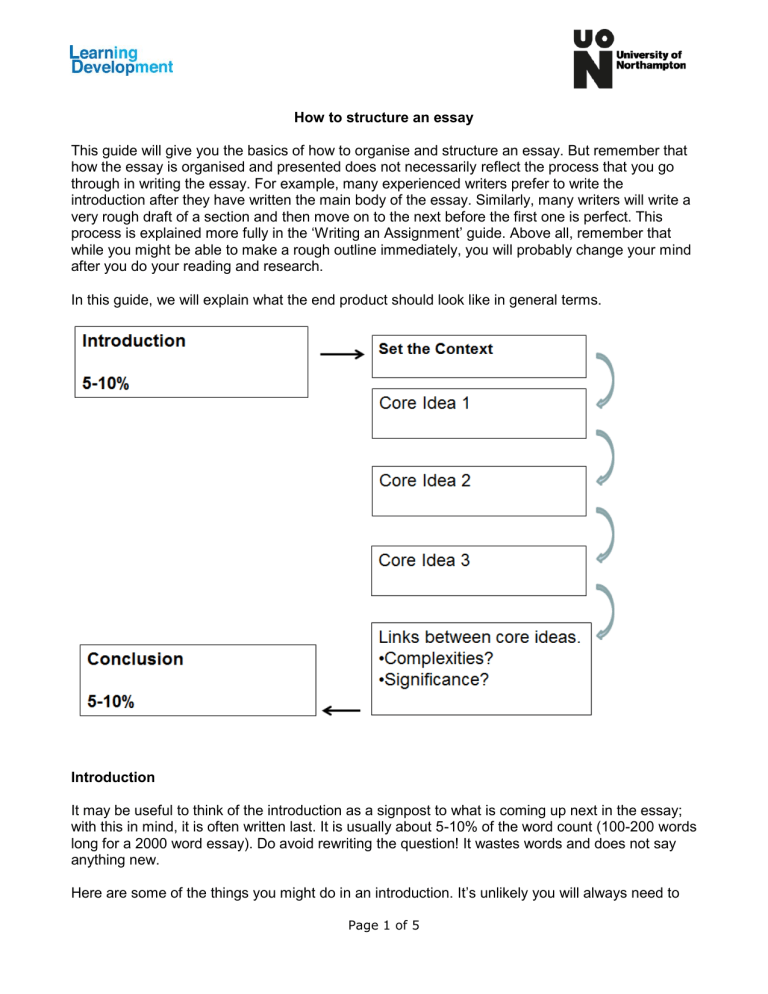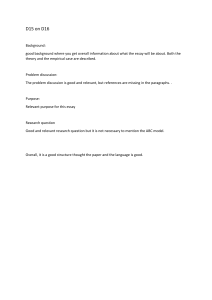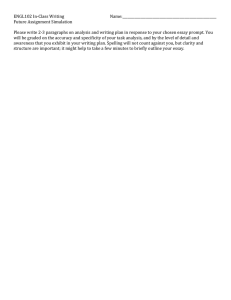
How to structure an essay This guide will give you the basics of how to organise and structure an essay. But remember that how the essay is organised and presented does not necessarily reflect the process that you go through in writing the essay. For example, many experienced writers prefer to write the introduction after they have written the main body of the essay. Similarly, many writers will write a very rough draft of a section and then move on to the next before the first one is perfect. This process is explained more fully in the ‘Writing an Assignment’ guide. Above all, remember that while you might be able to make a rough outline immediately, you will probably change your mind after you do your reading and research. In this guide, we will explain what the end product should look like in general terms. Introduction It may be useful to think of the introduction as a signpost to what is coming up next in the essay; with this in mind, it is often written last. It is usually about 5-10% of the word count (100-200 words long for a 2000 word essay). Do avoid rewriting the question! It wastes words and does not say anything new. Here are some of the things you might do in an introduction. It’s unlikely you will always need to Page 1 of 5 do all of them and depends on the length of the essay and its purpose (check your brief). But these might offer you a place to start - try doing each and then you can delete the parts which seem repetitive or irrelevant. 1. Set the scene or provide relevant background. 2. Introduce the topic or problem. 3. Give definitions ONLY IF NEEDED. Definitions are advisable in the following situations: a. It is a very complex or unusual concept or term, and the average member of the public would not know about it. b. There are multiple different definitions of the key term. In this case, you need to either write your own, or choose one that you are using throughout your essay. c. The academic definition is different from the common sense or daily use understanding. d. You wish to limit the aspects of the problem or topic on the basis of a strict definition (e.g. ‘Obesity is widely used as a term, but here it refers only to those people with a medical diagnosis and a BMI of over 30.00’). 4. Explain why the topic, statement or issue is important e.g. consider the size or scope of the problem or its implications. 5. Introduce the purpose of the essay: what are you attempting to do, and why? (NB: this may be unnecessary to write explicitly in the introduction, but it is always helpful to clarify it in your own mind). 6. Set out the argument or position you are taking in response to the topic, brief or issue. How are you going to answer the question? 7. Give an outline of the structure to explain your logic in the main body (e.g. ‘This essay will first present the key features of this theory, and then go on to explore its applications in healthcare contexts’.) Main body of your essay Develop your core ideas through the main body of the essay. You need paragraphs, sections and links. In a short assignment e.g. 1000 words or less, the structure of your essay is built only through your paragraphs. Longer assignments, over 2,000 words, will often be easier to organise if you break them down into 3-4 main sections, and then into paragraphs. The longer the assignment, the more important linking becomes to refer back to points you made earlier and connect ideas in one section to ideas in the next. Remember that your lecturer may have given you specific instructions about how to organise your assignment. If so, always follow them! If not, consider the following questions: ● What do I need to cover to answer the question? Write a list. ● How can I approach these topics analytically, rather than descriptively? What themes run across the topics? ● How can I divide up each topic or problem? What are the different aspects or dimensions to it? 1. Paragraphs: Each paragraph contains one core idea or main point. These points should relate closely to the overall argument or theme of your assignment. ○ Support these core ideas or “claims” with the evidence you have found from your Page 2 of 5 reading. Make sure you reference this. For more on paragraphs, see ‘How to write a paragraph’ guide. 2. Main sections: As your assignments get up to or over 2,000 words, start to think about sections or parts to the main assignment. ○ For example, you might have to first introduce a theory, and then talk about the different ways that this theory has been applied. How you determine what the content and divisions of your sections should be will depend on the assignment and the brief. ○ Whenever possible, create an outline and confirm it with your tutor. ○ Each of these sections will include 2 or more paragraphs. 3. Links: Maintain the flow between sections and paragraphs by making links and explaining connections between different ideas. ○ For example, you might present one side to an argument in one paragraph, and the opposing viewpoint in the next paragraph. You could begin the second paragraph with the sentence: ‘However, this viewpoint is by no means universal’, and then go on to explain why people disagree. ○ In a long assignment (e.g. over 2-3,000 words), you might find it useful to write mini-introductions to each section. In the draft stages, you can do this informally as a reminder or instruction to yourself (e.g. ‘In this section, I need to define the theory and show what different people have said about it and what the evidence is to support it’). In revision stages, this could be changed to a more formal style, or deleted (e.g. ‘This section presents the key features of the theory of X and critically discusses the evidence for it’). How you select your core ideas for main body sections or paragraphs depends largely on the essay title or brief you have been given. For example, if your title is ‘Describe the typical cognitive development of a healthy child between the ages of 2-4 years old’, you might either break it up into stages - this is what should be happening at 2 years old, 3 years old, and 4 years old - or divide it into different dimensions of cognitive development - language, thought, physical coordination, emotions, etc - and follow each one through separately. Similarly, if your title is to compare and contrast two different leadership styles for business management, you could either discuss each style one by one and then compare, or you could identify the important aspects of each style - e.g. communication styles, approaches to working, impact on team dynamics, and so on - and compare both leadership styles on the way they communicate, then on the way they both organise work, and so on. Now, the way that you choose to organise your assignment can have a significant impact on how critical and analytical you can be. For instance, if you try to compare and contrast two leadership styles, but take each one individually first, you will end up with a significant proportion of your assignment being descriptive, and the comparison happening only in the last section. Whereas if you follow the second approach suggested above, you are comparing and contrasting from the outset. In the second approach, you would need to briefly introduce and describe each style in the introduction. See final page for an extended example of an essay outline. Page 3 of 5 Conclusion The conclusion summarises the findings that have been presented without introducing new material. It is about the same size as the introduction. 1. Sum up or restate the main topics or issues. 2. What has been discovered? What do you know now that you did not know before? Ideally this should show that you have achieved the purpose that you set out in the introduction. 3. Is there an answer to the question? Have you proved your argument? 4. Highlight problem areas or suggest what further research is needed (if needed). NB. Problem areas with the topic or issue NOT with your essay. Limitations of word count, source availability or the author’s skill are not good things to mention here, because they reduce the reader’s confidence in your ability. 5. Do not introduce any new material. It is very tempting to list all of the things that you haven’t discussed, but try to avoid this. 6. Consider the implications of your conclusion. Who would it be relevant to? What does this mean for practitioners or workers in your area? Last words Essay structures are flexible: there is no perfect essay structure that will always work no matter what. Different approaches work well for different people, and in different situations. Some people write very well in a flowy, interconnected approach. Others find it easier to think in a block pattern where they deal with one topic, then move on to the next. Good writers try to balance the need for divisions and distinctions in their work between one section or topic and the next, and the importance of coherence and links between these ideas and topics. But the most important factor in determining your essay structure is the title or brief that you have been given. Time spent analysing the title, breaking down the topic and connecting what you have read to the brief, is always well spent. Page 4 of 5 Example essay outline: Title: Compare and contrast authoritarian leadership style with democratic leadership style, in the context of organisational change. Introduction: ● Context: introduce concept of leadership styles ● Importance: show evidence about the impact that effective leadership has on an organisation ● Main argument: While the democratic leadership style is more likely to encourage positive employee engagement, in situations of rapid organisational change or crisis, an authoritarian leadership style may be more effective. Section 1: motivation, engagement and discipline ● Paragraph 1: how do both styles motivate? which one engages teams more? ● Paragraph 2: how do both styles discipline? ● Give examples in different situations (i.e. relating to organisation change and stability) throughout ● Reach a conclusion e.g. that teams are more motivated, engaged and need less discipline when using a democratic style Section 2: communication and teamwork ● As above Section 3: developing ideas - where does the vision and the content come from? ● As above Section 4: micromanagement and delegation ● As above Conclusion: ● Sum up ● Draw all parts together ● Reiterate main argument ● Explain why this is a useful conclusion Page 5 of 5





